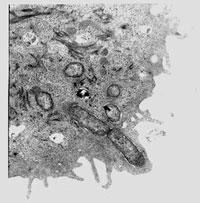To evolve you have to swallow
Eukaryotic cells absorbed some organelles by ingestion of bacteria. Examples of this are the mitochondria and chloroplasts of the plant cells. The nucleus is prior to the formation of these cells. There are scientists who believe it was formed by ingestion of some bacteria to others, but it is not easy to explain how one bacterium can ingest to another.

Some biochemicals at MIT have conducted a systematic study of eukaryotic cell proteins to clarify the origin of the nucleus. To do this, they have compared the proteins of a yeast and several eukaryotes.
A total of 2,000 proteins were analyzed. Of these, 900 are only in eukaryotes, some of which are not found in a eukaryote called Giardia. Giardia is the oldest eukaryotic known as the parasite, so it is closer to any other eukaryote since the time the nucleus was formed.
In 347 proteins related to eukaryotic formation, most participate in protein synthesis and cytoskeleton formation. According to scientists, these characteristics were collected from the direct ancestors of eukaryotes, to which scientists have called chronocytes.
The cytoskeleton supposes the ability to surround and swallow bacteria, so the chronocytes appropriated a bacterium that would become nucleus. That's what biochemists think. Compared to the current bacteria, the chronocytes had incredible powers.
Buletina
Bidali zure helbide elektronikoa eta jaso asteroko buletina zure sarrera-ontzian











